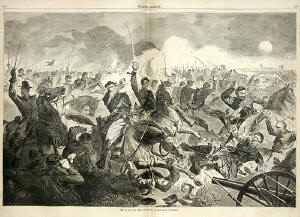The Cavalry Charge
![]()
This Site:
Starting a Collection
Top Picks
Online Gallery
Search Page
Order
Winslow Homer
Thomas Nast
Ken Burns Civil War
Up | Winslow Homer: Christmas in Camp | Civil War Infantry Charge | Rebel Soldiers | Union Army Before Yorktown | Union Cavalry | Winslow Homer: News from the Civil War | The Civil War Surgeon | The Cavalry Charge | The Civil War Bayonet Charge | Civil War Women | Winslow Homer: Civil War Sharpshooter | Winslow Homer: Soldiers on Picket Duty
Winslow Homer Civil War Art:The Cavalry Charge Many Artists serving as "War Illustrators" during the Civil War captured the nobility of war. Others captured the bravery of the individual soldier. Many images can be found celebrating victories, and lamenting defeats. Many war illustrators could create a profound sense of pride and accomplishment, and could capture the honor with which soldiers fought. Winslow Homer captured the stark reality of the brutality of war. |
July 5, 1862 - The War for the Union - The Cavalry Charge (Click on Image for an Enlarged View) |
|
Winslow Homer's Civil War was not a war of cannon or pistol. His war was not a war of honor or nobility. The war seen and presented by Winslow Homer was a war of the blade. It was a war of horror and death and unimaginable terror. Winslow Homer was haunted by what he saw, and his images show the terror that he experienced. If you have read my other reviews of Homer's Civil War art, you know of my belief that Homer was fixated on the bayonet. In most all of his illustrations, no matter what the overall topic or theme, the blades of the bayonet always come through as a dominant image. Beginning with the illustration of Abraham Lincoln's inauguration, we see the cold steel of the fixed bayonets jumping off the page. Homer's fixation on the blade comes to its full fruition in this image. Look at the images of terror on the faces of the men in this illustration. We see men facing death by the sword, and in their last moments on earth, experiencing absolute complete terror. On the faces of other men, we see a wild-eyed blood thirsty look as they prepare to put the enemy to the sword. Perhaps Homer's own terror is best captured in the looks on the horses' faces. Look at the horses' eyes. You can see that Homer has created compete terror on the faces of the horses. Their are images of over 100 bayonets, swords, and Bowie knives in this illustration. The image could perhaps have been better titled, "Homer's Nightmare". A Note to our Readers We acquired the images above for the purpose of digitally persevering them on this site for all to enjoy. With the digital archive complete, we are making the original, 140 year old illustrations available for purchase. By selling these original illustrations, we are able to acquire more material to archive on this site. If you are interested in purchasing one of the original Harper's Weekly leafs on this page, contact paul@sonofthesouth.net The leafs are available for a price of $250 a piece, and the proceeds will go to continue to expand the resources on this site. |
|
![]()
|
Email us at: paul@sonofthesouth.net. Copyright © 2003-2018 Son of the South.
|
|
|
|
Are you Scared and Confused? Click Here to read My Snake Story, a story of hope and encouragement, to help you face your fears. |
||
